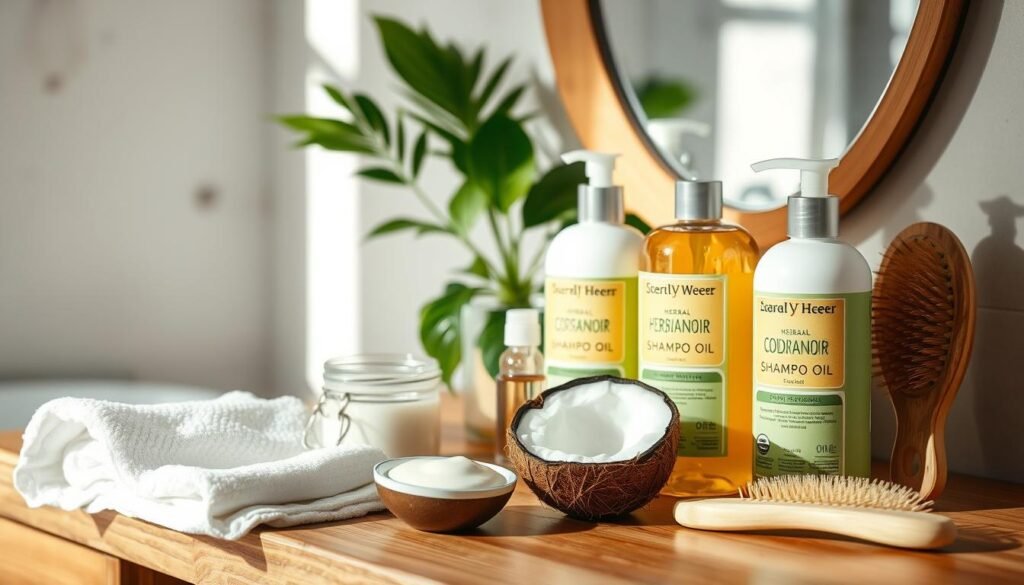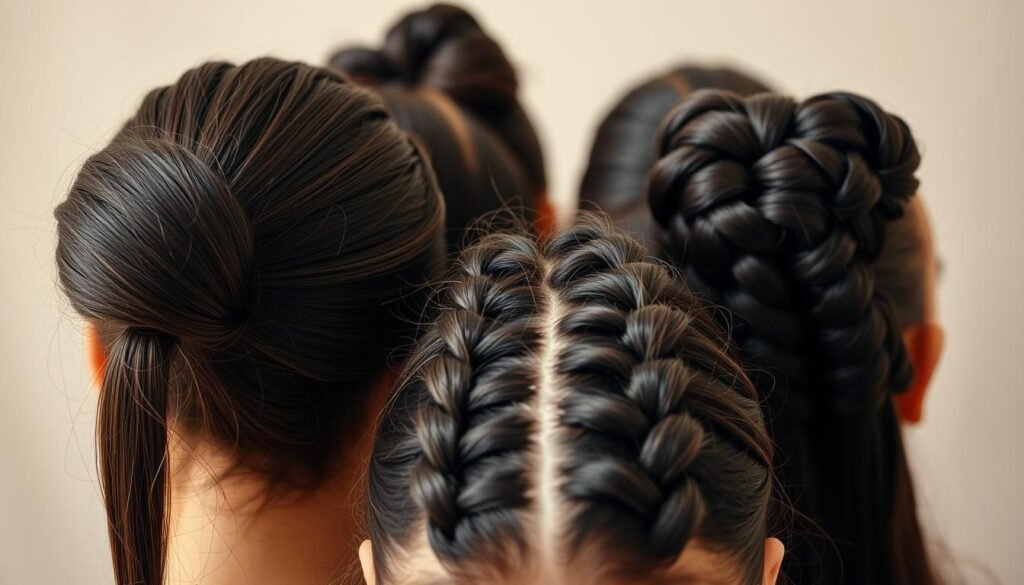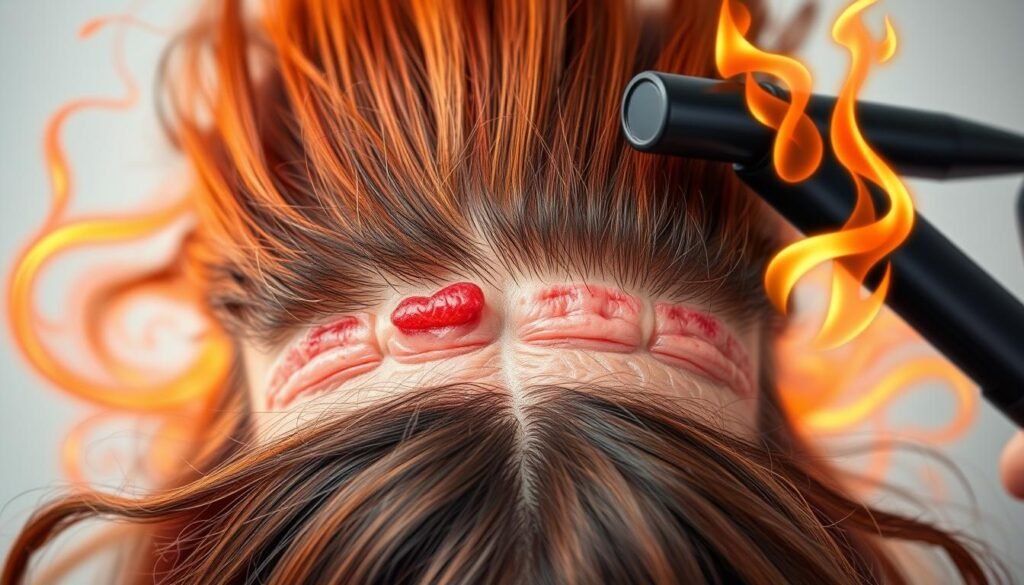Dandruff impacts nearly half of adults at some time. Certain habits after oiling your scalp can make it worse. This is because a fungus that feeds on sebum can cause dandruff. If we’re not careful, this can lead to uncomfortable itchy, dry, and red areas.
This piece sheds light on mistakes in hair care that stop dandruff treatments from working well. These errors can keep excessive oil on the scalp, making oily hair worse. Knowing these mistakes helps keep your scalp healthy. Let’s dive into how a wrong routine after oiling can increase flaking and irritation.
Key Takeaways
- Understanding causes of dandruff is key to preventing it.
- Oiling should be balanced to avoid exacerbation of oily hair problems.
- Post-oiling routines are crucial for promoting scalp health.
- Regular washing and the right hair products are important for dandruff treatment.
- Using suitable natural ingredients can help in controlling dandruff.
- Common hair care mistakes can lead to more severe dandruff issues.
Understanding Dandruff and Its Causes
Dandruff affects nearly half of adults around the globe. It shows as small, white flakes on the scalp, hinting at deeper scalp health issues. The reasons behind it include dry air, using the wrong hair care products, and a type of fungus called Malassezia. To really grasp dandruff, one must look at the various dandruff causes.
Often, dandruff hits men more than women, possibly pointing to gender links. Those with oily hair or certain health issues may also be more prone. Symptoms range from oily flakes and itching to irritated skin, eyebrow dandruff, and even dry flakes spreading to the face. Recognizing these signs is key to tackling the issue.
To keep scalp health in check, taking the right steps before problems start is crucial. Keeping your scalp clean, reducing stress, and not overusing shampoo can make a big difference in controlling dandruff. The American Academy of Dermatology Association suggests trying anti-dandruff shampoos with ketoconazole or zinc pyrithione. They also note that while home remedies like apple cider vinegar and coconut oil may help, their effectiveness isn’t proven by science.
| Factor | Impact on Dandruff |
|---|---|
| Age | More prevalent during teenage years and into midlife |
| Weather | Dry climates can exacerbate symptoms |
| Stress Levels | Increased stress may lead to flare-ups |
| Medical Conditions | Higher risk for individuals with conditions like HIV |
Getting to grips with dandruff is key for managing it well. If store-bought remedies don’t help after several weeks, or if things get worse, seeing a skin doctor is wise. They can offer guidance if your dandruff hints at other medical issues.
The Role of Oiling in Scalp and Hair Health
Oiling helps improve hair health a lot. A study in 2015 found that various oils can moisturize hair well. Oils like coconut and almond offer many pluses. They strengthen hair and protect it from harm. Scalp oil application gives both hydration and nourishment, helping hair grow healthy.
Finding the right oil for your hair type is key. Coconut oil is big in South Asia because of its lauric acid. This acid helps keep hair strong, as a 2021 study shows. Sesame oil is great for fighting dandruff and split ends. It also moisturizes well. Almond oil, which is full of vitamin E, helps hair grow by fighting stress. Changing oils based on your hair’s needs can be really helpful.
Ayurvedic practice advises making oiling a regular habit, doing it daily or twice weekly. Your hair’s needs, based on vata, pitta, and kapha doshas, are key. Choosing oils like argan, amla, or bhringraj can help meet these needs. They keep your scalp healthy.
Oiling regularly adds moisture and shine, protecting your hair. It shields hair from pollutants and harsh chemicals in shampoos. This defense helps prevent hair loss and keeps hair looking shiny. Using the right oils makes it easy to keep your hair looking its best.
| Oil Type | Key Benefits | Suggested Hair Type |
|---|---|---|
| Coconut Oil | Reduces protein loss, strengthens hair fibers | All hair types |
| Sesame Oil | Deep conditioning, prevents split ends | Vata type |
| Almond Oil | Rich in vitamins, combats oxidative stress | Pitta type |
| Argan Oil | Strengthens hair, acts as a natural conditioner | All hair types |
| Amla & Bhringraj Oil | Balances pitta dosha, promotes overall hair health | Pitta type |
What Not to Do After Oiling Your Scalp
Oiling your scalp helps a lot but following hair oiling best practices is key. If you don’t, you might end up with buildup or clogged follicles. Even dandruff could get worse. So, make sure to avoid these common mistakes for the best outcome.
Avoid Leaving Oil in Overnight
It might look okay to leave oil in your hair all night. Yet, this can block follicles and pull in dirt. Such long exposure can irritate your scalp and make dandruff worse. It’s better to keep the oil on for just two to three hours.
Afterward, washing it off with a sulfate-free shampoo is smart. This keeps your hair moist but clean. It lets you enjoy the benefits of the oil without bad side effects.
Do not Oil an Already Oily Scalp
Putting oil on a scalp that’s already oily is a bad idea. It makes your hair even greasier. The right move is to start with a clean scalp. Make sure to wash your hair well after oiling. This avoids any residue. It also ensures that other hair care items work well after.
Hair Care Mistakes That Exacerbate Dandruff
Many people make hair care mistakes that make their dandruff worse. One major error is over-oiling the scalp. This leads to buildup that not only increases dandruff but also causes oily hair and itching. Further, not keeping the scalp clean allows dead skin and oil to build up. This creates the perfect conditions for dandruff to flourish. Knowing these issues is key to managing dandruff better.
Over-Oiling Can Worsen Dandruff
Over-oiling is a common mistake for those wanting healthier hair. Too much oil can attract dirt and make the scalp dirty, worsening dandruff. It’s hard to remove excess oil, which can make flakiness and irritation worse. But, the right amount of oil can actually be good. It’s important to use just enough to nourish the scalp without overdoing it.
Ignoring Scalp Hygiene
Good scalp hygiene is critical for dandruff prevention and healthy hair. Not washing enough leads to sebum and dead skin buildup. A lot of people don’t realize how important it is to clean their scalp well. Using a gentle shampoo every other day can make a big difference. This will keep the scalp clean, reduce dandruff, and help hair grow healthy.

| Hair Care Mistake | Impact on Dandruff | Recommended Action |
|---|---|---|
| Over-oiling | Increases buildup and irritation | Use moderate amounts of oil |
| Infrequent washing | Allows dead skin and oil to accumulate | Wash every two days with mild shampoo |
| Neglecting scalp care | Contributes to weak hair and dandruff | Incorporate scalp serums into routine |
Post-Oiling Routine: Best Practices
A good post-oiling routine is key for great scalp care and keeping dandruff away. Using the right hair hygiene tips can remove extra oil and keep your scalp well-fed. The right methods after oiling your hair can greatly improve your hair’s health.
Importance of a Mild Shampoo
It’s crucial to pick a gentle shampoo for your post-oiling routine. Sulfate-free shampoos are best because they clean softly. They don’t take away the natural oils your hair needs to stay healthy. Using harsh products often can dry out your scalp and cause flakiness.
To use shampoo the right way, mix it in your hands first. This method cleans well without needing to scrub hard.
Proper Washing Techniques After Oiling
Washing your hair right after oiling is vital for keeping it clean and healthy. Here are some hair hygiene tips:
- Wash hair within 1-2 hours after oiling to prevent residue build-up.
- Use a clarifying shampoo at least once a month to remove any lingering oil.
- Massage the scalp with a shampoo brush for 1-2 minutes to promote circulation and enhance oil removal.
- Consider using a DIY hair rinse with lemon juice or apple cider vinegar to boost scalp cleanliness and prevent dandruff.
- Choose conditioners according to hair type, opting for hydrating, moisturizing, or deep-conditioning products.
Regular use of these tips can make a solid post-oiling routine. It will also keep your scalp in good shape. Following the right shampoo advice will give you shiny, smooth hair. Your hair will have less frizz, no extra oil, and no irritation.
How Tight Hairstyles Affect Dandruff
Tight hairstyles are more than just uncomfortable. They may not directly cause dandruff, but they impact scalp health. When hairstyles are too tight, they stress the hair follicles. This can lead to hair breakage and loss.
Studies show tight hairstyles can lead to traction alopecia. This condition makes hair loss worse, highlighting dandruff issues. That’s why choosing looser styles, especially after applying oil to the scalp, is key.
Oiling the scalp affects its natural oil balance. Paired with tight styles, it might worsen scalp health. An increase in sebum from oiling can cause irritation and boost dandruff problems. It’s crucial to consider how you style your hair for a healthy scalp.
For those battling dandruff, looking into specialized scalp health products is wise. Items with gentle ingredients, like jojoba oil and aloe vera, are recommended. Coupling this with a good diet can aid hair growth and scalp health.

Using the Wrong Products After Oiling
After oiling your hair, choosing the right products is key. Many hair products have harsh chemicals that can hurt your scalp. They can make scalp problems worse. Go for chemical-free oils and natural cures instead. They give your scalp the care it needs without causing harm. By picking the right scalp care tips, you help keep your hair healthy.
Harsh Chemicals vs. Natural Remedies
Harsh chemicals in products can make your scalp dryer and more irritated. But many people don’t realize that gentle, natural options work well. Aloe vera gel, for example, is great for soothing your scalp. It moisturizes without being oily. You can also try a mask made from yogurt and seeds, or mix egg, avocado, or bananas for scalp nourishment.
Dandruff can be tackled with natural cleansers like crushed neem leaves or neem oil. Ayurveda advises to wash off hair oil in 3-4 hours to keep hair follicles open. This way, natural cures work better. Using chemical-free oils cares for your hair and creates a better scalp environment.
Heat Styling and Its Impact on Scalp Health
Heat styling tools like blow dryers can hurt your scalp. Using them too much might make your scalp dry and irritated. It’s important to think about your scalp when you style your hair with heat.
Using heat often can weaken your scalp’s protection. This can cause dryness and flaking. To avoid hair damage, use less heat and follow good styling tips.
Heat protectants can lessen these bad effects. The Evalectric Crazy Pink Classic Styler has settings to control heat. This protects your scalp. Taking breaks from these tools helps your scalp heal and prevents dryness.
To keep your scalp and hair healthy, use nourishing routines like oiling your scalp. Eating foods rich in vitamins helps too. Taking good care of your scalp means you can still enjoy styling your hair with heat.

If you want to learn more about how heat affects your hair and scalp, check out this link. Using the right styling and protection methods leads to healthier hair even with heat styling.
Signs You Should See a Dermatologist
Keeping an eye on scalp health is key for good hair health. If you have symptoms that won’t go away, you might need a dermatologist. People with itchy scalps could have dandruff, ringworm, or lichen planus. Too much scratching can cause infections. So, it’s important to know when it’s time to get help.
Watching out for changes in how your scalp feels is smart. If your scalp problems don’t get better with regular cleaning and moisturizing in a month, see a doctor. Trying different scalp treatments for six months without results means you should see a specialist.
Knowing the signs of hair loss is crucial. Conditions like lupus or psoriasis can make your hair thin. Also, some medicines, like birth control or mood stabilizers, could cause hair loss. An oily scalp needs more care, which can block new hair from growing.
People with curly or fine hair might see different scalp issues. Curly hair holds onto oils, and fine hair can get oily fast. Hormones changing during puberty, pregnancy, or menopause can make the oil problem worse. This can lead to more hair and scalp problems.
The table below shows important signs that you might need a dermatologist:
| Signs | What They Indicate |
|---|---|
| Persistently itchy scalp | Possible infections or skin conditions |
| Excessive hair loss | Autoimmune issues or medication side effects |
| Failure of treatments | Need for specialized scalp care |
| Changes in scalp texture | Potential dermatological concerns |
Being aware of these signs helps in taking care of your scalp. Don’t wait too long to ask a dermatologist for advice if you have ongoing issues. To learn more about scalp problems and solutions, check out Buckhead Dermatology.
Conclusion
Understanding the do’s and don’ts of oiling is crucial for fighting dandruff effectively. Avoiding mistakes, like leaving oil on for too long or using too much, helps a lot. These actions help keep your scalp’s natural oils balanced and avoid problems.
Using the right method after oiling also matters. Applying oil properly and washing it off after a bit helps. Choose the right oil, like coconut for dry scalps and jojoba for oily ones, based on your hair’s needs. This custom approach leads to more vibrant and healthy hair.
Choosing the correct oil and applying it well can change your hair care game. For more tips on effective oiling, check out Love Beauty and Planet. This site offers lots of helpful advice for achieving healthy scalp and managing dandruff easily.